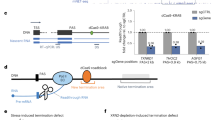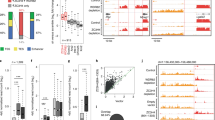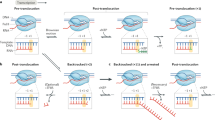Abstract
Active human promoters produce promoter-upstream transcripts (PROMPTs). Why these RNAs are coupled to decay, whereas their neighboring promoter-downstream mRNAs are not, is unknown. Here high-throughput sequencing demonstrates that PROMPTs generally initiate in the antisense direction closely upstream of the transcription start sites (TSSs) of their associated genes. PROMPT TSSs share features with mRNA-producing TSSs, including stalled RNA polymerase II (RNAPII) and the production of small TSS-associated RNAs. Notably, motif analyses around PROMPT 3′ ends reveal polyadenylation (pA)-like signals. Mutagenesis studies demonstrate that PROMPT pA signals are functional but linked to RNA degradation. Moreover, pA signals are under-represented in promoter-downstream versus promoter-upstream regions, thus allowing for more efficient RNAPII progress in the sense direction from gene promoters. We conclude that asymmetric sequence distribution around human gene promoters serves to provide a directional RNA output from an otherwise bidirectional transcription process.
This is a preview of subscription content, access via your institution
Access options
Subscribe to this journal
Receive 12 print issues and online access
$189.00 per year
only $15.75 per issue
Buy this article
- Purchase on Springer Link
- Instant access to full article PDF
Prices may be subject to local taxes which are calculated during checkout





Similar content being viewed by others
Accession codes
References
Affymetrix ENCODE Transcriptome Project, Cold Spring Harbor Laboratory ENCODE Transcriptome Project. Post-transcriptional processing generates a diversity of 5′-modified long and short RNAs. Nature 457, 1028–1032 (2009).
Jacquier, A. The complex eukaryotic transcriptome: unexpected pervasive transcription and novel small RNAs. Nat. Rev. Genet. 10, 833–844 (2009).
Lenhard, B., Sandelin, A. & Carninci, P. Metazoan promoters: emerging characteristics and insights into transcriptional regulation. Nat. Rev. Genet. 13, 233–245 (2012).
Seila, A.C. et al. Divergent transcription from active promoters. Science 322, 1849–1851 (2008).
Valen, E. et al. Biogenic mechanisms and utilization of small RNAs derived from human protein-coding genes. Nat. Struct. Mol. Biol. 18, 1075–1082 (2011).
Taft, R.J. et al. Tiny RNAs associated with transcription start sites in animals. Nat. Genet. 41, 572–578 (2009).
Kapranov, P. et al. RNA maps reveal new RNA classes and a possible function for pervasive transcription. Science 316, 1484–1488 (2007).
Sigova, A.A. et al. Divergent transcription of long noncoding RNA/mRNA gene pairs in embryonic stem cells. Proc. Natl. Acad. Sci. USA 110, 2876–2881 (2013).
Preker, P. et al. RNA exosome depletion reveals transcription upstream of active human promoters. Science 322, 1851–1854 (2008).
Flynn, R.A., Almada, A.E., Zamudio, J.R. & Sharp, P.A. Antisense RNA polymerase II divergent transcripts are P-TEFb dependent and substrates for the RNA exosome. Proc. Natl. Acad. Sci. USA 108, 10460–10465 (2011).
Preker, P. et al. PROMoter uPstream Transcripts share characteristics with mRNAs and are produced upstream of all three major types of mammalian promoters. Nucleic Acids Res. 39, 7179–7193 (2011).
Nechaev, S. & Adelman, K. Pol II waiting in the starting gates: regulating the transition from transcription initiation into productive elongation. Biochim. Biophys. Acta 1809, 34–45 (2011).
Anamika, K., Gyenis, A., Poidevin, L., Poch, O. & Tora, L. RNA polymerase II pausing downstream of core histone genes is different from genes producing polyadenylated transcripts. PLoS ONE 7, e38769 (2012).
Kuehner, J.N., Pearson, E.L. & Moore, C. Unravelling the means to an end: RNA polymerase II transcription termination. Nat. Rev. Mol. Cell Biol. 12, 283–294 (2011).
Derti, A. et al. A quantitative atlas of polyadenylation in five mammals. Genome Res. 22, 1173–1183 (2012).
Beaudoing, E., Freier, S., Wyatt, J.R., Claverie, J.M. & Gautheret, D. Patterns of variant polyadenylation signal usage in human genes. Genome Res. 10, 1001–1010 (2000).
Salisbury, J., Hutchison, K.W. & Graber, J.H. A multispecies comparison of the metazoan 3′-processing downstream elements and the CstF-64 RNA recognition motif. BMC Genomics 7, 55 (2006).
Martin, G., Gruber, A. R., Keller, W. & Zavolan, M. Genome-wide analysis of pre-mRNA 3′ end processing reveals a decisive role of human cleavage factor I in the regulation of 3′ UTR length. Cell Rep. 1, 753–763 (2012).
Yao, C. et al. Transcriptome-wide analyses of CstF64-RNA interactions in global regulation of mRNA alternative polyadenylation. Proc. Natl. Acad. Sci. USA 109, 18773–18778 (2012).
Proudfoot, N.J. Ending the message: poly(A) signals then and now. Genes Dev. 25, 1770–1782 (2011).
Richard, P. & Manley, J.L. Transcription termination by nuclear RNA polymerases. Genes Dev. 23, 1247–1269 (2009).
Core, L.J., Waterfall, J.J. & Lis, J.T. Nascent RNA sequencing reveals widespread pausing and divergent initiation at human promoters. Science 322, 1845–1848 (2008).
Kaida, D. et al. U1 snRNP protects pre-mRNAs from premature cleavage and polyadenylation. Nature 468, 664–668 (2010).
Core, L. J. et al. Defining the status of RNA polymerase at promoters. Cell Rep. 2, 1025–1035 (2012).
Wyers, F. et al. Cryptic pol II transcripts are degraded by a nuclear quality control pathway involving a new poly(A) polymerase. Cell 121, 725–737 (2005).
Gudipati, R.K., Villa, T., Boulay, J. & Libri, D. Phosphorylation of the RNA polymerase II C-terminal domain dictates transcription termination choice. Nat. Struct. Mol. Biol. 15, 786–794 (2008).
Buratowski, S. Progression through the RNA polymerase II CTD cycle. Mol. Cell 36, 541–546 (2009).
Neil, H. et al. Widespread bidirectional promoters are the major source of cryptic transcripts in yeast. Nature 457, 1038–1042 (2009).
Xu, Z. et al. Bidirectional promoters generate pervasive transcription in yeast. Nature 457, 1033–1037 (2009).
Zarudnaya, M.I., Kolomiets, I.M., Potyahaylo, A.L. & Hovorun, D.M. Downstream elements of mammalian pre-mRNA polyadenylation signals: primary, secondary and higher-order structures. Nucleic Acids Res. 31, 1375–1386 (2003).
Andersen, P.K., Lykke-Andersen, S. & Jensen, T.H. Promoter-proximal polyadenylation sites reduce transcription activity. Genes Dev. 26, 2169–2179 (2012).
Takahashi, H., Kato, S., Murata, M. & Carninci, P. CAGE (cap analysis of gene expression): a protocol for the detection of promoter and transcriptional networks. Methods Mol. Biol. 786, 181–200 (2012).
Dobin, A. et al. STAR: ultrafast universal RNA-seq aligner. Bioinformatics 29, 15–21 (2013).
Pelechano, V., Wilkening, S., Jarvelin, A.I., Tekkedil, M.M. & Steinmetz, L.M. Genome-wide polyadenylation site mapping. Methods Enzymol. 513, 271–296 (2012).
Wilkening, S. et al. An efficient method for genome-wide polyadenylation site mapping and RNA quantification. Nucleic Acids Res. 41, e65 (2013).
Wu, T.D. & Nacu, S. Fast and SNP-tolerant detection of complex variants and splicing in short reads. Bioinformatics 26, 873–881 (2010).
Marstrand, T. T. et al. Asap: a framework for over-representation statistics for transcription factor binding sites. PloS One 3, e1623 (2008).
Portales-Casamar, E. et al. JASPAR 2010: the greatly expanded open-access database of transcription factor binding profiles. Nucleic Acids Res. 38, D105–D110 (2010).
Acknowledgements
We thank M. Schmid and S. Lykke-Andersen for comments on the manuscript as well as P. Carninci and H. Takahashi for help with the CAGE protocol and S. Wilkening with the 3′ tag protocol. This work was supported by the Danish National Research Foundation (grant DNRF58), the Villum Kann Foundation and the Danish Cancer Society (T.H.J.); the EU 7th Framework Programme (FP7/2007–2013)/European Research Council grant agreement 204135, the Novo Nordisk and Lundbeck Foundations (A. Sandelin); and University of Luxembourg—Institute for Systems Biology Program and the Deutsche Forschungsgemeinschaft (L.M.S.). A. Schein was supported as a recipient of a European Molecular Biology Organization postdoctoral grant.
Author information
Authors and Affiliations
Contributions
E.N., J.B., A. Sandelin and T.H.J. designed the experiments. E.N., J.B., M.B., A. Schein, P.R.A., P.K.A. and P.P. performed the experiments. A.I.J., Y.C., M.J., R.A., I.H., E.V., X.Z., J.B., V.P., L.M.S. and A. Sandelin did the bioinformatics analyses. E.N., A. Sandelin and T.H.J. wrote the manuscript. All authors have critically read and approved of the manuscript.
Corresponding author
Ethics declarations
Competing interests
The authors declare no competing financial interests.
Supplementary information
Supplimentery Figures and Tables
Supplementary Figures 1–6 and Supplementary Tables 1–5 (PDF 5950 kb)
Rights and permissions
About this article
Cite this article
Ntini, E., Järvelin, A., Bornholdt, J. et al. Polyadenylation site–induced decay of upstream transcripts enforces promoter directionality. Nat Struct Mol Biol 20, 923–928 (2013). https://doi.org/10.1038/nsmb.2640
Received:
Accepted:
Published:
Issue Date:
DOI: https://doi.org/10.1038/nsmb.2640
This article is cited by
-
Differential regulation of mRNA stability modulates transcriptional memory and facilitates environmental adaptation
Nature Communications (2023)
-
Screening thousands of transcribed coding and non-coding regions reveals sequence determinants of RNA polymerase II elongation potential
Nature Structural & Molecular Biology (2022)
-
Beyond the canonical role of TFIIB in eukaryotic transcription
Current Genetics (2022)
-
Phylogenetic comparison and splice site conservation of eukaryotic U1 snRNP-specific U1-70K gene family
Scientific Reports (2021)
-
A first exon termination checkpoint preferentially suppresses extragenic transcription
Nature Structural & Molecular Biology (2021)



